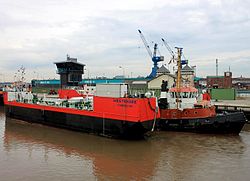Westensee (ship)
|
Oil control ship Westensee in Bremerhaven
|
||||||||||||||
|
||||||||||||||
|
||||||||||||||
|
||||||||||||||
|
||||||||||||||
The Westensee is a vehicle for fighting oil and pollutants. The owner is the Bremerhaven Waterways and Shipping Authority . It is managed by Bugsier-, Reederei- und Bergungs-GmbH & Co. KG ( Bremerhaven branch ).
The vehicle was built at the Nobiskrug shipyard in Rendsburg . The keel was laid on February 12, 1984, the launch in June 1984. The vehicle was also completed in June.
The Westensee is a floating oil dike. The vehicle does not have its own drive and has to be pushed by a tractor when in use , which limits the mobility of the system.
As a result of the dynamic pressure on the 15 m wide ramp between the two fuselage parts, the oil flows into the oil sump, from where it flows into the tanks, which have a total capacity of 1,960 m³ (150 m³ oil sump, 2 × 560 m³ settling tanks, 2 × 345 m³ collection tank), can be pumped.
To prevent the formation of a vortex that would direct oil under the hull, there is a weir in front of the ramp. The efficiency of the system decreases significantly with increasing wave heights, since the ramp is then flooded with water and additional water gets into the oil sump. Even at a wave height of 2 m, the efficiency of the system drops to around 65 percent, while in calm water, up to 90 percent of the oil can be siphoned off the surface of the water.
The Westensee is used by the average command in Cuxhaven . In the context of international agreements such as the Agreement on Cooperation in Combating Pollution of the North Sea by Oil and Other Pollutants (Bonn Agreement) or the Convention on the Protection of the Marine Environment of the Baltic Sea Area ( HELCOM ), the vehicle can also be used by oil or pollutant accidents other states can be requested.
The vehicle is named after the lake of the same name in Schleswig-Holstein .
Web links
- "Westensee" on the website of the Bugsier-, Reederei- und Bergungsgesellschaft mbH & Co. KG
- Ship details Westensee. DNV GL , accessed on November 23, 2017 .
Individual evidence
- ↑ Numerical analysis of the interaction of a carrier ship with a decoupled oil skimmer in the sea, student thesis in the marine technology department of the Institute for Land and Sea Transport at the Technical University of Berlin, November 2004, page 8
